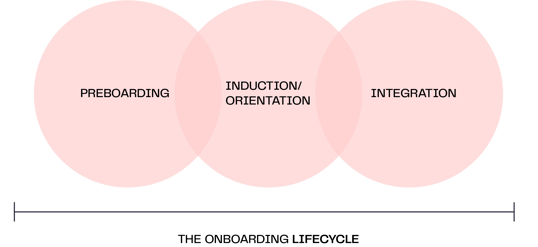Bringing a new hire on board is an essential and often complex process. From the time between signing the contract to the first crucial day and following months of integration, a new hire’s journey is the stepping stone to success within your organization.
But while many companies employ a great new-recruit process, more than 22% are flying blind, mistaking induction and orientation for onboarding, and missing opportunities to engage and delight their ambassadors of tomorrow.
So. Let’s unpack it. What IS onboarding? And how is it different to induction and orientation? To truly understand, we need to know exactly what each of these terms means in isolation.

 |
Induction
|
Traditionally induction is the process of welcoming your new team member into the fold. It might involve a powerpoint presentation on team culture, a meet-and-greet with relevant co-workers and maybe even a buddy system to ease first-day nerves. Induction is short term, it’s usually a one-and-done activity completed on a new hires first day.
Induction might include:
- Welcome Booklet / Company Culture PowerPoint
- Office Tour / Meet & Greet
- Buddy System
- ‘Welcome’ Morning Tea
- Company Swag Bag
In one sentence: A process to welcome new hires to the organization and its culture.
 |
Orientation
|
Orientation is all about compliance and getting your new hire up to speed on processes, paper-work and the general administration of your company. Orientation is a short term activity, often done-and-dusted by the end of a new recruits first week.
Orientation might include:
- Pay Roll / Expense Process Introduction
- Computer / Phone Allocation and Guidelines
- Brand Style-Guide Overview
- Travel Card Set-up
- Company Policy Documentation [Health & Safety / Privacy / Emergency Contacts]
In one sentence: A process to familiarize new hires with company policy and guidelines.
Orientation and Induction go hand-in-hand and are necessary parts of any new hire journey. But they both represent a short-term vision for your newest colleague.
That is where onboarding comes in.

 |
Onboarding
|
Onboarding is an umbrella term that spans the full new hire lifecycle. From signing their contract, and landing on Day 1 [pre-boarding], during their first days and weeks on the job [induction & orientation], through until they are fully settled in their new role - whether that’s 3 weeks, 3 months or even a year [integration].
It is a long-term strategy and recognizes that a staggering 20% of new hires leave for a new opportunity within the first 45 days on the job.
The purpose is to deliver an ongoing, all-inclusive experience that builds loyalty and confidence through what we call the four prongs of exceptional employee onboarding:
- Organizational [Administration, Policy, Documentation]
- Functional [Training, Goal Setting, Performance Reviews]
- Social [Connection Building, Welcome Drinks, Buddy-Mentoring]
- Cultural [Setting Expectations, Company Purpose & Vision, Stakeholder Engagement]
In one sentence: A comprehensive, 2-way process designed to share knowledge, communicate values, build connections and manage compliance to transform new hires into confident, empowered team members and ambassadors.
 |
The Takeaway
|
Induction and orientation are important pieces of the new job puzzle, but many companies begin and end with only this. Building an all-encompassing onboarding process can increase retention by over 82%, boost productivity by over 70%, and ultimately create a culture in which your new hires will THRIVE.
Want to learn how to make deliver meaningful experiences at every stage of the new hire lifecycle?
Try our 2023 whitepaper for future-proof ideas that impact engagement, time-to-productivity, and new hire retention.






